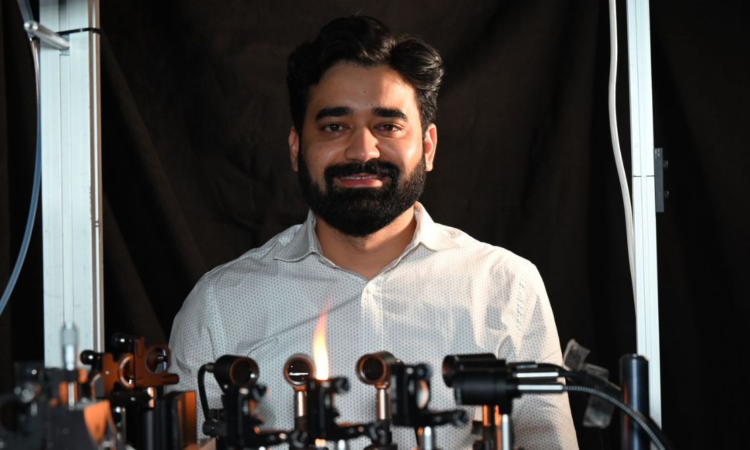This scientist from Uttar Pradesh village has developed the world’s fastest laser sheet imaging tech – The Indian Express

For young scientist Yogeshwar Nath Mishra, the journey from Azamgarh in Uttar Pradesh to California was not easy. His father, a farmer, made a lot of sacrifices to let him achieve his dreams. The struggle, however, bore fruit as Mishra is now part of a team at NASA, Caltech that has invented the world’s fastest laser sheet imaging technology that can help in the study of nanoparticles in flames.
“Right from a young age, I was fascinated by the world of science. The late aerospace scientist and former Indian President APJ Abdul Kalam deeply inspired me,” Mishra, a scientist at NASA-Jet Propulsion Laboratory at Caltech, told indianexpress.com.
Scientific innovations over the years have helped in addressing critical issues that have been impacting humanity and the planet. Mishra has achieved something that can make a significant change in the understanding of combustion.
“Regular cameras have 30 frames per second when it comes to capturing images. We have achieved 12.5 billion frames per second. Unlike existing systems that only throw images that come in the line of sight via a laser beam limiting the area, we work on laser sheet imaging. It essentially gives two-dimensional information of a plane,” said Mishra whose research has been published in the peer reviewed journal Nature Light Science & Application.
The team used a light sheet to cut through a three-dimensional object, to give information about a specific segment of the object. The invention, according to Mishra, is the fastest camera for planar imaging. The modern ultra-fast cameras that are used for similar imaging are limited to million frames per second. In the latest innovation, the team has combined compressed sensing with streak camera technology.
“One can only see the light’s origin and where it goes, however, its movement in real-time is impossible to trace. But this camera lets you see light in action. Essentially how light travels in a material or a medium. And all this is possible, because of the 12.5 billion frames per second capability,” said Mishra adding that they combined compressed sensing algorithm and streak technology to make this camera single-shot and two-dimensional.
Mishra, whose research interests include laser spectroscopy, light-matter interaction, and sustainable technologies, believes that the new imaging system can give significant leverage to studies on combustion. According to the scholar, combustion leads to the formation of several chemical species from hydrocarbons. Similarly, flying an aeroplane or launching a rocket leads to the burning of hydrocarbons, making it imperative to understand the phenomenon.
“It is a very complex process with a lot of fluid mechanics, chemistry and physics involved. So it is important to understand it better as it may help us in improving engine performance,” he said. The scientist also said that the burning of fuel leads to soot formation. Soot formed in nanoparticles can contribute to numerous health hazards after they get into the bloodstream. It is also a catalyst to global warming.
This soot, according to Mishra, gets transported to glaciers and other surfaces with ice forming a layer on them. Since they trap sunlight, soot increases the temperature resulting in the melting of glaciers.
“The soot formation process starts from the Poly Aromatic Hydrocarbons (PAH) which are nano-sized particles that are formed just before soot. So this new technology with its ultra-fast imaging will let us track how PAH is responsible for the formation of soot particles. Ultra-fast imaging is needed as the formation lasts within nanoseconds and sub-nanoseconds,” explains Mishra adding that the ultra-fast imaging could prove to be a boon to other areas such as biomedical imaging, or tracking any process which is induced by light.
Speaking about the cost of technology, Mishra said that the latest system came at a considerably lower cost than existing imaging systems enabling effortless adoption across labs and research facilities. Mishra said that his colleagues at Caltech have been extremely supportive and were key to his invention.
Although beaming with pride over his achievements, Mishra rued the dearth of acknowledgement back home. While India has produced some of the brightest scientists, as of today, science as a career seems to be fast losing a foothold among youths. During his stint at Lund University in Sweden, Mishra said that there were five research fellows from China, while he was the only Indian scientist.
“When it comes to fostering scientists, in India the biggest thing that we lack today is adequate funding.” According to Mishra, there is a need for more scholarships for PhD scholars to conduct research abroad the way China and other nations facilitate their academicians.
When asked what is stopping Indian youth from pursuing science, Mishra believes that it has more to do with the mindset. There are brilliant students who ace in math and physics, but at the end of the day, they will be persuaded by their parents to settle for high-paying IT jobs. However, in science, from masters to PhD, it is a long-winding route and there are no shortcuts. Most parents in India bear hefty education costs, hence it is only plausible for youths to gravitate towards high-paying jobs.
“My father is a farmer and he managed to give me a good education for which I am truly grateful. From selling lands to many other sacrifices, my family supported my vision and ensured that my academic pursuits were smooth,” said Mishra who is also affiliated to the University of Gothenburg, Sweden.
The research scientist is greatly inspired by APJ Abdul Kalam, Kalpana Chawla, and CV Raman. For him, getting to study at the University of Texas Arlington, where late astronaut Kalpana Chawla also studied, was a moment of pride. “Walking into the Kalpana Chawla Hall at the University of Texas was an emotional moment for me.”
India-Maldives ties: Amid row, why the 2 countries need eachPremium Story
The legal dispute over Aligarh Muslim University's minority characterPremium Story
Did your salary beat the inflation rate in Modi years?Premium Story
How Lakshadweep’s unique cultural landscape developedPremium Story
UPSC Key, January 10: What to read today and whyPremium Story
4 guidelines to understand Trump vs BidenPremium Story
What the animal world teaches fathers about raising childrenPremium Story
Is the Earth becoming warmer?Premium Story
By sending Bilkis convicts back to jail, SC reasserts itsPremium Story
Ex-envoy: ISI tipped off India about plot to hit KashmirPremium Story
UPSC Key, January 9: What you should read today andPremium Story
Why do politicians rush to give direct benefits (cash) toPremium Story
The true story of the Jolly Joseph casePremium Story
Uma Bharti interview: ‘We've no copyright on Ram Bhakti'Premium Story
‘Badalta Kashmir’: Meet rappers whose song on Valley is makingPremium Story
Bijin Jose is a Technology Journalist currently serving as an Assistant Editor for Indian Express Online in New Delhi. Passionate about the transformative power of technology, he delves into its multifaceted impact on our lives and the broader world. His intrigue with technology's vast potential began in his youth, setting the stage for his career. His writing journey commenced at Maharaja Sayajirao University, Vadodara, where he pursued a BA in English. Simultaneously, he took on the role of a citizen journalist with The Times of India, shedding light on Vadodara's civic challenges. After completing his MA in English Literature, he transitioned to a senior correspondent role at TOI, focusing on crime reporting for print while also crafting features on the city's culture, art, and heritage. He embraced the digital realm in 2016 with India Today Digital. Starting as desk staff, he swiftly rose to lead the online news team. His versatility shone when he undertook a mixed-media role at the Times of India's New Delhi bureau, orchestrating interviews with diplomats and defense personnel and covering pivotal events for the Response Editorial segment. A passionate film enthusiast, he has penned movie reviews and standpoint features, contributing to The Economic Times and DailyO. In 2021, his focus shifted to technology journalism with The Economic Times. By 2023, he found his niche at The Indian Express, where he continues to produce insightful features on the ever-evolving world of technology. His reporting and stories are marked by his knack for simplifying complex concepts, enlightening readers with the latest developments. … Read More 

 Bijin Jose<span style="font-weight: 400">Bijin Jose is a Technology Journalist c… read more
Bijin Jose<span style="font-weight: 400">Bijin Jose is a Technology Journalist c… read more







